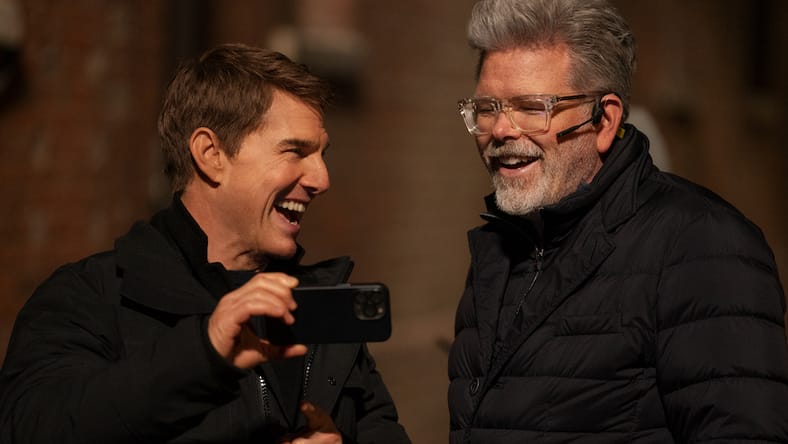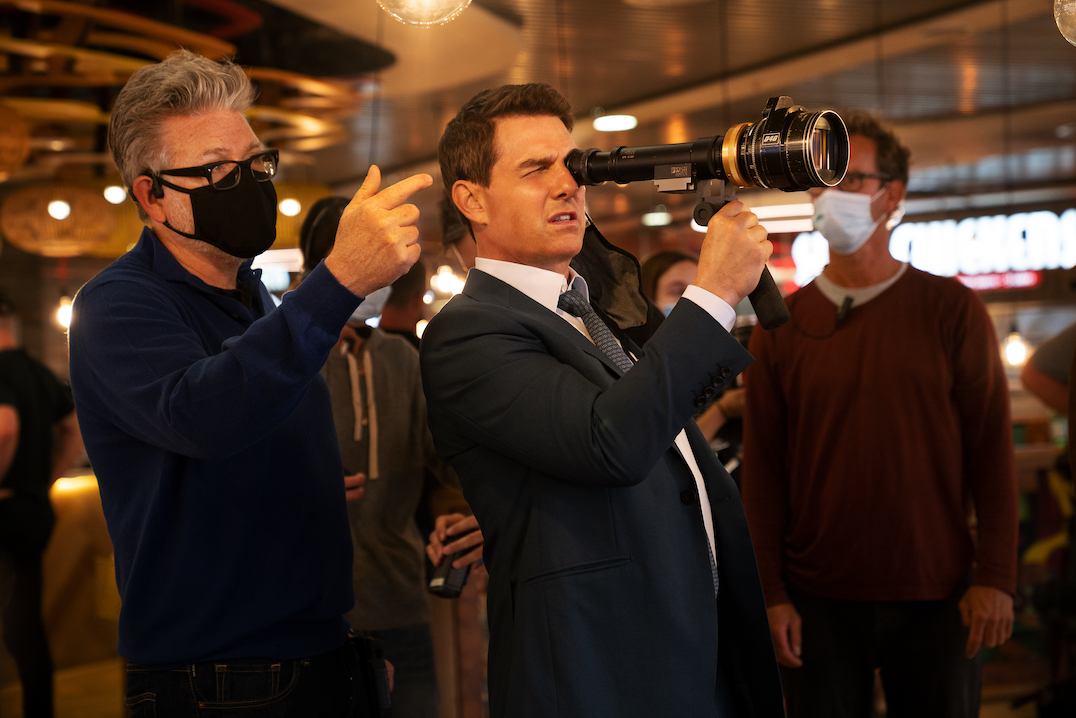
Christopher McQuarrie and Tom Cruise argued all the time during the making of Mission Impossible – Dead Reckoning — about how to keep you, the viewer, entertained for every second of the film.
“I get asked all the time, ‘Do you and Tom ever argue?’ Yes, we argue every single day on your behalf. It’s not about my vision or Tom’s vision. It’s about your experience,” McQuarrie told MovieMaker.
McQuarrie has directed two previous films in the series, Mission: Impossible – Rogue Nation and Mission: Impossible – Fallout, and his stunning track record with Cruise goes back to 2008’s Valkyrie, which McQuarrie co-wrote. He first directed Cruise in 2012’s Jack Reacher.
Joining the fast-moving Mission: Impossible franchise nearly a decade ago meant trying to keep up a goal of making every movie outdo the last. Loud, gorgeous, and heartfelt, their films are like the grandest of operas with the finest musicians performing. Sometimes they get close to the stratosphere — as in the HALO jump for Fallout.
But for an especially thrilling scene in Dead Reckoning, they imposed a limitation (and some mild spoilers follow): putting Cruise behind the wheel of a tiny Fiat for a race through Rome.
“You lose all sense of time because you’re going so fast. It’s so dangerous,” McQuarrie told MovieMaker. “Filming car chases is very chaotic. We were in Rome for a little over two weeks, with only three or four hours to film at some locations.”
Here’s our Q&A with McQuarrie about how research begets more research, how a little Zed camera can create a depth of perception, and the perils of chasing a stone downhill.
Sonya Alexander: How do you prepare the visual language for a film like Mission: Impossible – Dead Reckoning Part One?
Christopher McQuarrie: We were very determined to make a very different film from the previous Mission Impossibles. We want to keep the notion alive that these films evolve visually, from the first film all the way through to the present. A lot of that was looking back on it. Looking at what had worked. Looking at what we could improve upon.
I worked with cinematographer Frasar Taggart, our gaffer Martin Smith who does all of our lighting, and Jonathan “Chunky” Richmond, my first assistant camera operator… We were a little bit of a brain trust in constantly finding ways to keep the camera moving and keep the scenes alive. And always creating a little sense of instability in the story because of the chaos in the narrative.
Christopher McQuarrie on Shooting the Fiat Chase
Sonya Alexander: Do you have any particular cameras you like to use for action sequences, like the Fiat chase?
Christopher McQuarrie: It’s less about the cameras and more about the lenses. In this particular sequence, for the chase in Rome, we used what was called a Zed cam. It is a very small, very flexible, very versatile camera. And larger cameras simply wouldn’t have worked because the Fiat itself is simply so small.

We tried putting a full-sized camera on it and it was bigger than the car itself. I don’t know if you remember The Flintstones, when they put the food tray on the car… that’s literally what it looked like when you put cameras on it. You couldn’t see through the windshield.
And that’s how we make these movies. The action dictates the kind of camera that we’re working with. We explore every medium. What it comes right down to is what camera can get the job done and in many cases what camera can survive.
Sonya Alexander: What was the biggest challenge of doing the submarine scene?
Christopher McQuarrie: The biggest challenge of the submarine scene was that a lot of what you are seeing is inside a space with no windows. There’s no way to see outside. There’s no way to create a three-dimensional geography. You don’t really know where the submarine is in three- dimension space. All of our action sequences are about geography.
It was about creating the instruments inside the submarine to get a sense of how the submariners felt the world around them and understood 3D space. And all of that blocking is meant to put you in a submarine the way the crew would be there and creating that sense of spatial awareness.
The other thing is it’s just a very cramped environment, built on a gimbal. The set could roll twenty degrees in all directions. It was very challenging. It was a very tight space. A lot of those actors weren’t terribly experienced. In fact, one of the actors, it was his first time on camera. They were extraordinary. Over the course of shooting that scene, they really became the crew.
A ‘Little Spoiler’ About Mission Impossible — Dead Reckoning Part 2
Sonya Alexander: When you do the research for these films, do you come across info that inspires future storylines?
Christopher McQuarrie: Yes, absolutely. The submarine was a really good example of one. The research we were doing for that particular sequence inspired what’s going to happen with the rest of the story, particularly as it relates to submarines. There’s a little spoiler for you.
Sonya Alexander: What is the greatest strength of this film compared to the others?
Christopher McQuarrie: I think that every film that Tom and I do takes all of the knowledge that we’ve acquired from the previous films, and we apply it to that film. So, you’re watching a film that’s benefitting from all the previous Mission Impossibles, Edge of Tomorrow, Top Gun: Maverick.
Everything we’ve learned, we’ve applied it here and we never stop. We never believe that we know everything. We’re constantly confronting each other, confronting the narrative, and we’re always trying to learn. We never get too comfortable to think that we’ve got it all figured out. When you think you know what you’re doing, that’s when you get surprised.
Also Read: Who Is the Enemy in Top Gun: Maverick?
Christopher McQuarrie on Arguing With Tom Cruise
Sonya Alexander: You’ve collaborated with Tom a lot. What do you enjoy most about your collaborations?
Christopher McQuarrie: There’s no ego. There is no particular set of rules other than you’ve got to entertain the audience. We need to engage the audience every single instant of the movie. In a strange way, the audience is there with us in every story meeting, in every test screening, in the editing room, on the set.
You’re making the movie with us because we’re constantly thinking about what your experience is going to be. And it makes it a very democratic process. It’s not really about who’s right and who’s wrong. It’s all about what’s right for the audience. That allows us to eliminate conflict.
If he has an idea that I don’t understand or I have an idea that he doesn’t understand, we just proceed and take it on its natural course and it either works or it doesn’t. But ultimately, it’s about whether or not you’re having a good time in the movie. I get asked all the time, “Do you and Tom ever argue?” Yes, we argue every single day on your behalf. It’s not about my vision or Tom’s vision. It’s about your experience.
Sonya Alexander: Since you’re the writer and director, what pressures do you feel to actualize the visuals and story from the page?
Christopher McQuarrie: The way I like to describe it — writing is pushing a boulder up a mountain, directing is running down the mountain with the boulder after you. Everybody is waiting for you when you’re the screenwriter. They’re all waiting for those pages. It’s the blueprint for how the movie is made.
It’s a very lonely and solitary place to be. And when you’re directing, the clock starts. The firehose is on, and you have to drink from it. You’re responsible not only for the enormous budget of the film, but you’re also responsible for the safety of all of the people around you. It’s a lot to balance on the head of a pin.
Mission: Impossible – Dead Reckoning Part One arrives in theaters, including IMAX, on Wednesday.
Main image: Tom Cruise and Christopher McQuarrie on the set of Mission: Impossible Dead Reckoning Part One from Paramount Pictures and Skydance.
